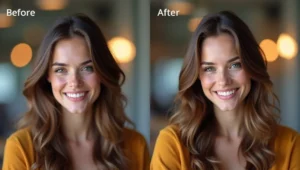Why Your Ads Aren’t Working (And How AI Can Fix That)
You’ve just spent three hours writing ad copy for your latest campaign. You’ve rewritten it seven times. You’ve asked your colleagues for feedback. You’ve second-guessed every word. And when you finally launch it… crickets. No clicks. No sales. Just another ad lost in the endless scroll of the internet.
- Why Your Ads Aren’t Working (And How AI Can Fix That)
- What Is AI Ad Copy Writing? (Explained Like You’re Five)
- Why Marketing Agencies and Small Businesses Need AI for Ad Copy
- The Challenge of Modern Advertising
- 💖 You Might Also Like
- How AI Solves These Problems
- The Best AI Tools for Writing Ad Copy
- 1. Jasper AI: The Professional’s Choice
- ✨ More Stories for You
- 2. Copy.ai: The User-Friendly Option
- 3. ChatGPT: The Versatile Powerhouse
- 4. Anyword: The Data-Driven Specialist
- 🌟 Don’t Miss These Posts
- 5. Writesonic: The Budget-Friendly Performer
- How to Actually Use AI for Writing Ad Copy (Step-by-Step)
- Step 1: Know Your Audience (Really Know Them)
- Step 2: Define Your Goal
- Step 3: Input the Right Information
- Step 4: Generate Multiple Versions
- Step 5: Edit and Refine
- Step 6: Test, Measure, and Improve
- Real-World Examples: AI Ad Copy That Actually Works
- Example 1: Local Coffee Shop
- Example 2: Marketing Agency Promoting Their Services
- Example 3: Online Fitness Program
- Common Mistakes to Avoid When Using AI for Ad Copy
- Mistake 1: Using AI Copy Without Editing
- Mistake 2: Not Being Specific Enough
- Mistake 3: Ignoring Your Brand Voice
- Mistake 4: Not Testing Multiple Versions
- Mistake 5: Forgetting the Human Touch
- Tips for Getting Better Results with AI Ad Copy Tools
- Tip 1: Study Successful Ads First
- Tip 2: Create a Swipe File
- Tip 3: Use the “Problem-Agitate-Solution” Framework
- Tip 4: Include Power Words
- Tip 5: Create Variations for Different Platforms
- Tip 6: Ask for Explanations
- How Small Businesses Can Compete with Big Brands Using AI
- Strategy 1: Speed to Market
- Strategy 2: Hyper-Personalization
- Strategy 3: Continuous Testing and Optimization
- Strategy 4: Lower Costs, Higher ROI
- What Marketing Agencies Need to Know About AI Ad Copy
- Why Agencies Are Adopting AI
- How to Integrate AI Into Your Agency
- The Future of Agencies and AI
- The Future of AI Ad Copy Writing
- Trend 1: Even More Personalization
- Trend 2: Voice and Video Integration
- Trend 3: Predictive Analytics
- Trend 4: Real-Time Optimization
- Trend 5: Cross-Platform Coordination
- Getting Started: Your Action Plan
- Week 1: Choose Your Tool
- Week 2: Learn the Basics
- Week 3: Create Your First Real Campaign
- Week 4: Analyze and Optimize
- Month 2 and Beyond: Expand and Refine
- Final Thoughts: The AI Advantage
Sound familiar?
Here’s the good news: You’re not alone. And there’s a solution that’s transforming how marketing agencies and small businesses create advertising copy. It’s called AI (Artificial Intelligence), and it’s like having a professional copywriter working for you 24/7, without the coffee breaks.
In this guide, we’re going to explore the best AI tools for writing ad copy. Whether you run a bustling marketing agency or you’re a small business owner wearing all the hats, you’ll discover how to create ads that actually work—faster, easier, and better than ever before.
What Is AI Ad Copy Writing? (Explained Like You’re Five)
Let’s start with the basics. What exactly is AI ad copy writing?
Imagine you have a super-smart robot friend who has read millions of successful ads from all over the world. This friend knows what words make people click, what phrases create excitement, and what messages turn browsers into buyers. Now imagine this friend could write ads for you in seconds.
That’s essentially what AI ad copy tools do.
They use something called “machine learning” (don’t worry, it’s not as complicated as it sounds). Basically, these tools have studied countless examples of great advertising and learned the patterns that make ads successful. When you tell them what you’re selling and who you’re selling to, they use these patterns to create ad copy that’s likely to work.
Think of it like this: If you wanted to learn to bake cookies, you could experiment for years, or you could learn from someone who’s already baked thousands of perfect cookies. AI is that experienced baker, but for advertising.
Why Marketing Agencies and Small Businesses Need AI for Ad Copy
The Challenge of Modern Advertising
Here’s the thing about advertising today: It’s harder than ever before.
Why? Because your potential customers see thousands of ads every single day. On Facebook, Instagram, Google, YouTube, TikTok—ads are everywhere. And most people have developed what we call “banner blindness.” They scroll right past ads without even noticing them.
💖 You Might Also Like
To break through this noise, your ad copy needs to be:
- Attention-grabbing in the first second
- Relevant to your specific audience
- Clear and easy to understand
- Persuasive enough to make people take action
- Different enough to stand out from competitors
Creating ads like this takes time, skill, and lots of testing. And if you’re a small business owner, you probably don’t have hours to spend writing and testing ad copy. You’re too busy running your actual business.
If you’re a marketing agency, you’re juggling multiple clients, each with different products, audiences, and brand voices. Creating fresh, effective ad copy for all of them can feel like an impossible task.
This is where AI becomes your secret weapon.
How AI Solves These Problems
AI ad copy tools solve these challenges in several powerful ways:
Speed: What takes a human hours takes AI seconds. Need 50 different ad variations? Done in two minutes.
Consistency: AI doesn’t have bad days. It delivers quality copy every single time, whether it’s Monday morning or Friday evening.
Testing: Want to test different headlines, different calls-to-action, different approaches? AI can generate dozens of variations instantly, so you can test and find what works.
Data-Driven: AI doesn’t guess. It uses data from millions of successful ads to create copy that’s statistically likely to perform well.
Cost-Effective: Instead of hiring expensive copywriters or spending hours doing it yourself, AI gives you professional-quality copy for a fraction of the cost.
The Best AI Tools for Writing Ad Copy
Now let’s get to what you really want to know: Which AI tools should you actually use? Here’s a breakdown of the best options for marketing agencies and small business advertisers.
1. Jasper AI: The Professional’s Choice
What It Is: Jasper is like the Swiss Army knife of AI writing tools. It’s powerful, versatile, and trusted by over 100,000 businesses worldwide.
Why It’s Great for Ad Copy: Jasper has specific templates designed for different types of ads—Facebook ads, Google ads, product descriptions, and more. You simply fill in some basic information about your product and target audience, and Jasper generates multiple ad copy options.
Best For: Marketing agencies handling multiple clients and small businesses that want professional-level copy without the professional price tag.
How It Works: Imagine you’re selling organic dog treats. You tell Jasper: “Product: Organic Dog Treats. Audience: Health-conscious pet owners. Tone: Friendly and trustworthy.” Within seconds, Jasper gives you 5-10 different ad headlines and body copy options to choose from.
✨ More Stories for You
The Catch: Jasper is more expensive than some alternatives, but many users say it’s worth every penny because the quality is consistently high.
2. Copy.ai: The User-Friendly Option
What It Is: Copy.ai is designed to be incredibly easy to use. If you’re new to AI tools and find technology intimidating, this is your best friend.
Why It’s Great for Ad Copy: Copy.ai has over 90 templates, including specific ones for Facebook ads, Google ads, Instagram captions, and more. The interface is simple—you answer a few questions, click a button, and boom, you have ad copy.
Best For: Small business owners who aren’t tech-savvy and want something that just works without a learning curve.
How It Works: You select the type of ad you want (like “Facebook Ad Primary Text”), enter your product name and description, choose your tone, and Copy.ai generates multiple options. You can then edit, regenerate, or mix and match different parts.
The Catch: While it’s very user-friendly, some users find that the copy sometimes needs more editing compared to other tools. But for the price and ease of use, it’s still an excellent choice.
3. ChatGPT: The Versatile Powerhouse
What It Is: You’ve probably heard of ChatGPT—it’s the AI that took the world by storm. While it’s not specifically designed for ad copy, it’s incredibly powerful when used correctly.
Why It’s Great for Ad Copy: ChatGPT can create virtually any type of content, including ad copy. The key is knowing how to ask (we call this “prompting”). Give it clear instructions about your product, audience, and desired outcome, and it will create compelling ad copy.
Best For: People who want flexibility and don’t mind spending a little time learning how to write good prompts. Also great if you want one tool that can do ads, emails, blog posts, and more.
How It Works: Instead of templates, you have a conversation with ChatGPT. You might say: “I need 5 Facebook ad headlines for a new productivity app targeting busy entrepreneurs. The main benefit is it saves them 2 hours per day. Make it punchy and include curiosity gaps.” ChatGPT will then generate options based on your instructions.
The Catch: It takes practice to get really good results consistently. You need to learn how to give clear, detailed instructions. But once you get the hang of it, it’s incredibly powerful.
4. Anyword: The Data-Driven Specialist
What It Is: Anyword is different from other AI tools because it focuses heavily on predicting performance. It doesn’t just create copy—it tells you which copy is likely to perform best.
Why It’s Great for Ad Copy: Anyword analyzes your copy and gives it a “Predictive Performance Score.” This score tells you how well your ad is likely to perform before you even launch it. It’s like having a crystal ball for your advertising.
Best For: Marketing agencies and businesses that run a lot of ads and want to maximize ROI through data-driven decisions.
How It Works: You input your product information and target audience. Anyword generates multiple ad variations and gives each one a performance score. You can see which version is predicted to get the most clicks, conversions, or engagement. You can also analyze what makes certain words or phrases perform better.
🌟 Don’t Miss These Posts
The Catch: It’s more expensive than basic AI tools, but if you’re spending serious money on ads, the improved performance can easily justify the cost.
5. Writesonic: The Budget-Friendly Performer
What It Is: Writesonic is an AI writing tool that offers excellent value for money. It provides high-quality ad copy at a price that small businesses can afford.
Why It’s Great for Ad Copy: Writesonic has templates for virtually every type of ad you might need—Google ads, Facebook ads, LinkedIn ads, Amazon product descriptions, and more. It also offers features like ad copy optimization and A/B testing suggestions.
Best For: Small businesses and startups on a tight budget who still want quality AI-generated ad copy.
How It Works: Similar to Copy.ai, you select a template, fill in information about your product and audience, and generate copy. What makes Writesonic special is that it often generates longer-form copy that gives you more to work with and edit.
The Catch: The free plan is quite limited, but even the paid plans are very affordable compared to competitors.
How to Actually Use AI for Writing Ad Copy (Step-by-Step)
Knowing which tools exist is one thing. Knowing how to use them effectively is another. Here’s a simple, step-by-step process that works for any AI ad copy tool.
Step 1: Know Your Audience (Really Know Them)
Before you touch any AI tool, you need to understand who you’re talking to. The better you know your audience, the better your AI-generated copy will be.
Ask yourself these questions:
- Who is my ideal customer? (Age, gender, occupation, interests)
- What problems do they have that my product solves?
- What language do they use? (Formal? Casual? Technical? Simple?)
- What are their biggest fears or desires related to my product?
- Where do they hang out online?
Write down the answers. The more specific you are, the better. For example, instead of “small business owners,” try “busy restaurant owners in their 40s who struggle with social media marketing and want more customers without spending hours online.”
Step 2: Define Your Goal
What do you want your ad to accomplish? Different goals require different approaches.
Common ad goals include:
- Generate awareness (introduce people to your brand)
- Drive traffic (get people to visit your website)
- Generate leads (collect email addresses or contact information)
- Make sales (convince people to buy right now)
- Build engagement (get likes, comments, shares)
Be specific about your goal before you start generating copy. An ad designed to build awareness will look very different from an ad designed to make immediate sales.
Step 3: Input the Right Information
Now you’re ready to use your AI tool. Most tools will ask for similar information:
Product/Service Name: What are you selling?
Description: What does it do? What makes it special? What benefits does it provide?
Target Audience: Who are you selling to? (Use the information from Step 1)
Tone of Voice: How should the ad sound? Professional? Funny? Urgent? Friendly? Inspirational?
Call-to-Action: What do you want people to do? (Buy now, sign up, learn more, etc.)
The more detailed and specific you are with this information, the better your results will be. Don’t just say “dog treats.” Say “organic, grain-free dog treats that improve digestion and give dogs more energy, made with human-grade ingredients.”
Step 4: Generate Multiple Versions
Here’s a secret: Don’t just generate one ad and call it done. Create at least 5-10 different versions.
Why? Because testing is how you find what really works. What sounds good to you might not resonate with your audience. By generating multiple versions, you increase your chances of finding a winner.
Most AI tools make this easy—you can generate new versions with a single click.
Step 5: Edit and Refine
AI is powerful, but it’s not perfect. You should always review and edit the copy it generates.
Things to check:
- Is the copy factually accurate about your product?
- Does it match your brand voice and personality?
- Is it clear and easy to understand?
- Does it have a strong call-to-action?
- Would you actually click on this ad if you saw it?
Don’t be afraid to mix and match. Take the headline from version 1, the body copy from version 3, and the call-to-action from version 7. Frankenstein your way to perfection.
Step 6: Test, Measure, and Improve
Launch your ads and track how they perform. Which headlines get the most clicks? Which body copy drives the most conversions? Which calls-to-action work best?
Use this data to improve your next round of ads. You can also feed this information back into your AI tool. For example: “Generate 5 more versions like the headline that got a 5% click-through rate, but make them even more curiosity-driven.”
This cycle of generate, test, measure, and improve is how you continuously get better results over time.
Real-World Examples: AI Ad Copy That Actually Works
Let’s look at some before-and-after examples to see the difference AI can make.
Example 1: Local Coffee Shop
Before (Written by Owner): “Come to Joe’s Coffee. We have great coffee and pastries. Open 7am-6pm daily. Located on Main Street.”
After (AI-Generated): “Tired of mediocre morning coffee? Start your day with locally roasted, award-winning beans that actually wake you up. Plus, pastries so fresh they’re still warm. First cup free for new customers! ☕”
What Changed: The AI version creates a problem (mediocre coffee), offers a specific solution (award-winning beans), includes sensory details (still warm), and has a compelling call-to-action (first cup free).
Example 2: Marketing Agency Promoting Their Services
Before: “We are a full-service marketing agency offering SEO, social media, content marketing, and PPC services. Contact us today.”
After (AI-Generated): “Tired of throwing money at ads that don’t work? Our clients see an average 312% ROI in their first 90 days. We handle your marketing so you can handle your business. Free strategy call – no pitch, just insights. 📈”
What Changed: The AI version speaks to a pain point (wasted ad spend), includes specific proof (312% ROI), positions the benefit clearly (you focus on your business), and offers a low-risk next step (free call).
Example 3: Online Fitness Program
Before: “Join our 8-week fitness program. Includes workout plans and meal guides. Only $99.”
After (AI-Generated): “Still wearing ‘someday’ jeans? 8 weeks from today, they’ll fit—or your money back. No gym needed, no weird diets, just 20-minute workouts and meal plans you’ll actually enjoy. 5,000+ transformations and counting. Start your ‘after’ photo today. 💪”
What Changed: The AI version creates an emotional hook (someday jeans), removes objections (no gym needed, no weird diets), includes social proof (5,000+ transformations), offers a guarantee (money back), and creates urgency (start today).
Common Mistakes to Avoid When Using AI for Ad Copy
AI is powerful, but it’s easy to use it wrong. Here are the biggest mistakes people make—and how to avoid them.
Mistake 1: Using AI Copy Without Editing
Just because AI generated it doesn’t mean it’s perfect. Always review and edit the copy. Make sure it’s factually correct, on-brand, and appropriate for your audience.
Some people copy and paste AI-generated ads without reading them carefully, then wonder why they don’t perform well. Don’t be that person.
Mistake 2: Not Being Specific Enough
Vague input creates vague output. If you tell AI to “write an ad for a business,” you’ll get generic, boring copy. If you tell AI to “write a Facebook ad for a sustainable fashion brand targeting environmentally conscious millennials who value style and ethics,” you’ll get something much better.
The more specific you are about your product, audience, and goals, the better your results will be.
Mistake 3: Ignoring Your Brand Voice
AI doesn’t automatically know your brand personality. If you’re a fun, casual brand, but you don’t tell the AI to use that tone, you might get formal, corporate-sounding copy that doesn’t match your vibe.
Always specify the tone and personality you want. Give examples if possible. “Write this in a tone similar to how Wendy’s tweets—sassy but not mean, funny but still professional.”
Mistake 4: Not Testing Multiple Versions
One of AI’s biggest advantages is speed—it can generate dozens of versions in minutes. Yet many people generate one version and stop there.
Don’t do that. Generate at least 5-10 versions. Test them. See what works. This is how you find the winners.
Mistake 5: Forgetting the Human Touch
AI is a tool, not a replacement for human creativity and judgment. The best results come when you combine AI efficiency with human insight.
Use AI to generate options quickly, but use your knowledge of your business and customers to select and refine the best versions. Add personal touches, insider knowledge, and emotional intelligence that only a human can provide.
Tips for Getting Better Results with AI Ad Copy Tools
Want to take your AI ad copy to the next level? Here are some pro tips.
Tip 1: Study Successful Ads First
Before you start generating copy, spend time looking at successful ads in your industry. What do they have in common? What language do they use? What emotions do they tap into?
When you understand what works, you can give better instructions to your AI tool.
Tip 2: Create a Swipe File
Keep a collection of great ads you come across. When you need inspiration or want to give your AI tool examples to work from, you’ll have a library ready to go.
You can tell your AI: “Write an ad similar in style to this successful ad I saw,” and then paste the example.
Tip 3: Use the “Problem-Agitate-Solution” Framework
This is a classic copywriting formula that works incredibly well for ads:
- Identify a problem your audience has
- Agitate that problem (make them feel it)
- Present your product as the solution
Tell your AI tool to use this framework, and your ads will be more persuasive.
Tip 4: Include Power Words
Certain words have been proven to grab attention and drive action. Words like: free, new, proven, guaranteed, instantly, limited, exclusive, easy, and discover.
Ask your AI to incorporate relevant power words into your copy.
Tip 5: Create Variations for Different Platforms
An ad that works on Facebook might not work on LinkedIn. An Instagram ad needs different copy than a Google search ad.
Generate platform-specific versions. Each social platform has a different audience with different expectations and behaviors.
Tip 6: Ask for Explanations
Many AI tools (especially ChatGPT) can explain why they made certain choices in the copy. Ask: “Why did you use that headline?” or “What makes this version likely to perform well?”
Understanding the reasoning behind the copy helps you learn and improve your own copywriting skills over time.
How Small Businesses Can Compete with Big Brands Using AI
One of the most exciting things about AI ad copy tools is that they level the playing field. Small businesses can now create ad copy that rivals what big brands pay expensive agencies thousands of dollars for.
Here’s how small businesses are using AI to punch above their weight:
Strategy 1: Speed to Market
Big brands often take weeks to create and approve ad campaigns. As a small business, you can use AI to create and launch campaigns in hours. This speed advantage means you can capitalize on trends, react to competitors, and test ideas while bigger companies are still in meetings.
Strategy 2: Hyper-Personalization
AI makes it easy to create many different ad versions for different audience segments. While big brands often run one-size-fits-all campaigns, you can have specific ads for different customer types, locations, interests, and behaviors.
Someone interested in budget options sees different copy than someone interested in premium options. Someone in New York sees different copy than someone in Texas. This personalization dramatically improves results.
Strategy 3: Continuous Testing and Optimization
Big brands run campaigns in flights—they create ads, run them for a set period, analyze results, then start over. You can test and optimize continuously.
Generate new variations every week. Test them against your current ads. Keep what works, discard what doesn’t. This constant improvement means your ads get better and better over time.
Strategy 4: Lower Costs, Higher ROI
Instead of paying thousands for a copywriter or agency, you pay a small monthly fee for an AI tool. This cost savings means you can invest more in actually running the ads, reaching more people, and growing faster.
What Marketing Agencies Need to Know About AI Ad Copy
If you run a marketing agency, AI ad copy tools aren’t just useful—they’re becoming essential to staying competitive. Here’s why.
Why Agencies Are Adopting AI
Client Expectations: Clients increasingly expect faster turnarounds and more variations to test. AI makes this possible without burning out your team.
Scalability: You can take on more clients without proportionally increasing your team size. One person with AI tools can do the work that used to require three or four copywriters.
Consistency: Every client gets the same high quality, whether they’re your biggest account or your smallest.
Profitability: Spend less time on routine copywriting and more time on strategy, client relationships, and high-value services. This improves your margins significantly.
How to Integrate AI Into Your Agency
Start with Training: Make sure your team understands what AI can and can’t do. Provide training on the specific tools you choose.
Establish Workflows: Create clear processes for when and how to use AI. For example: “AI generates first drafts, senior copywriters refine and finalize.”
Maintain Quality Control: Always have a human review AI-generated copy before it goes to clients. This ensures brand consistency and catches any errors or off-brand elements.
Be Transparent: Some agencies tell clients they use AI tools, others don’t mention it. There’s no right answer, but make sure whatever you choose aligns with your values and client contracts.
Combine AI with Human Expertise: The best approach is AI for speed and options, humans for strategy, refinement, and that final polish that makes great copy exceptional.
The Future of Agencies and AI
AI won’t replace copywriters and strategists—it will enhance them. The agencies that thrive will be those that combine AI efficiency with human creativity, strategic thinking, and deep understanding of their clients’ businesses.
Think of AI as a junior copywriter that works incredibly fast but still needs guidance and editing from more experienced professionals.
The Future of AI Ad Copy Writing
Where is this all heading? Here are some trends to watch.
Trend 1: Even More Personalization
Future AI tools will create ads personalized not just to audience segments, but to individual people. Imagine ads that automatically adjust based on the weather in someone’s location, the time of day, their recent browsing history, and current events in their area.
Trend 2: Voice and Video Integration
Right now, most AI ad tools focus on text. But AI is rapidly improving at creating voice-overs and even video content. Soon you’ll be able to generate complete video ads, not just the copy.
Trend 3: Predictive Analytics
AI will get better at predicting which ads will work before you even run them. You’ll be able to test virtually without spending real ad budget, dramatically reducing wasted spend.
Trend 4: Real-Time Optimization
AI will automatically adjust your ad copy in real-time based on performance. If a certain headline isn’t working, AI will automatically swap it out for a better performer without you having to intervene.
Trend 5: Cross-Platform Coordination
Future AI tools will coordinate your messaging across all platforms automatically. They’ll ensure your Facebook ads, Google ads, email campaigns, and website all tell a cohesive story while being optimized for each specific platform.
Getting Started: Your Action Plan
Ready to start using AI for your ad copy? Here’s your step-by-step action plan.
Week 1: Choose Your Tool
Pick one AI tool to start with. Based on your situation:
- If you’re a marketing agency: Start with Jasper or Anyword
- If you’re a small business owner new to this: Try Copy.ai
- If you want maximum flexibility: Use ChatGPT
- If you’re on a tight budget: Try Writesonic
Most tools offer free trials. Take advantage of these to test before committing.
Week 2: Learn the Basics
Spend time learning your chosen tool. Watch tutorial videos, read the documentation, and experiment with generating copy for products or services you know well.
Don’t worry about creating perfect ads yet. Just get comfortable with how the tool works.
Week 3: Create Your First Real Campaign
Choose one product or service to focus on. Use everything you’ve learned in this guide to create 5-10 different ad variations.
Launch these ads with a small budget (even $5-10 per day is enough to start getting data).
Week 4: Analyze and Optimize
Look at your results. Which ads performed best? Why do you think that is? What can you learn?
Generate new variations based on what worked. Turn off what didn’t work. This testing and optimization process is how you continuously improve.
Month 2 and Beyond: Expand and Refine
As you get more comfortable, expand to more products, more platforms, and more sophisticated campaigns. Keep learning, keep testing, keep improving.
The businesses seeing the best results from AI ad copy tools are those that commit to continuously learning and optimizing. It’s not a set-it-and-forget-it solution—it’s a powerful tool that gets better the more you use it.
Final Thoughts: The AI Advantage
We’re living through a revolution in advertising. For the first time ever, small businesses and lean marketing agencies have access to the same level of copywriting power that used to be available only to major brands with huge budgets.
AI ad copy tools aren’t magic. They won’t automatically make you rich or famous. But when used correctly, they give you a massive advantage:
Speed: Create in minutes what used to take hours Quality: Generate professional-level copy consistently Testing: Try dozens of variations to find what works Learning: Improve your own copywriting skills by studying what AI creates Scalability: Handle more campaigns without burning out
The businesses winning with advertising right now aren’t necessarily the ones with the biggest budgets. They’re the ones using the best tools and strategies—and AI is one of the most powerful tools available.
So stop spending hours struggling with ad copy. Stop hiring expensive agencies for simple campaigns. Stop wondering why your ads don’t work as well as you hoped.
Start using AI to create better ads, faster, with less stress. Your future customers are out there right now, scrolling through their feeds. Make sure your ads are good enough to make them stop scrolling and start clicking.
The future of advertising is here. It’s powered by AI. And it’s available to you right now.
What are you waiting for? Your next successful campaign is just a few clicks away.
About the Author: This guide was created to help marketing agencies and small business owners navigate the rapidly evolving world of AI advertising tools. Whether you’re running your first campaign or your thousandth, the right tools can make all the difference. Start small, test often, and never stop learning.
Questions? The best way to learn is by doing. Pick a tool, start experimenting, and discover what works for your unique business. Every successful advertiser was once a beginner—the difference is they started.














